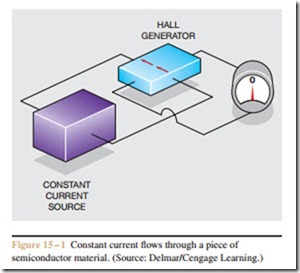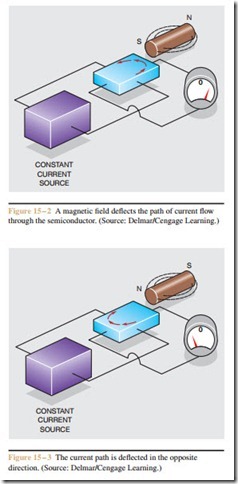Principles of Operation
The Hall effect is a simple principle that is widely used in industry today. The Hall effect was discovered by Edwin H. Hall at Johns Hopkins University in 1879. Mr. Hall originally used a piece of pure gold to produce the Hall effect, but today a piece of semiconductor material is used because semiconductor material works better and is less expensive to use. The device is often referred to as the Hall generator.
Figure 15 – 1 illustrates how the Hall effect is produced. A constant current power supply is connected to opposite sides of a piece of semiconductor material. A sensitive voltmeter is connected to the other two sides. If the current flows straight through the semiconductor material, no voltage is produced across the voltmeter connection.
Figure 15 – 2 shows the effect of bringing a magnetic field near the semiconductor material. The magnetic field causes the current flow path to be deflected to one side of the material. This causes a potential or voltage to be produced across the opposite sides of the semiconductor material.
If the polarity of the magnetic field is reversed, the current path is deflected in the opposite direction, as shown in Figure 15 – 3. This causes the polarity of the
voltage produced by the Hall generator to change. Two factors determine the polarity of the voltage produced by the Hall generator:
1. the direction of current flow through the semicon- ductor material; and
2. the polarity of the magnetic field used to deflect the current.
The amount of voltage produced by the Hall generator
is determined by:
1. the amount of current flowing through the semicon- ductor material; and
2. the strength of the magnetic field used to deflect the 0 current path.
The Hall generator has many advantages over other types of sensors. Since it is a solid-state device, it has no moving parts or contacts to wear out. It is not affected by dirt, oil, or vibration. The Hall generator is an integrated circuit that is mounted in many different types and styles of cases.

